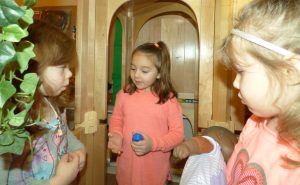 Two children were having a heated discussion regarding the distribution of toy cars. We decided that the problem could best be solved by visiting the Peace Table. In case you missed the introduction before, the Peace Table is a special place where two or more friends can work together to solve a problem.
Two children were having a heated discussion regarding the distribution of toy cars. We decided that the problem could best be solved by visiting the Peace Table. In case you missed the introduction before, the Peace Table is a special place where two or more friends can work together to solve a problem.
Both children amicably sat down and I began my usual spiel. To each child I asked, “What do you want?” Both stated that they wanted to make a football game with the cars. One child had been previously playing in the area before moving to make a ramp for a separate game. The other child, inspired by the first, moved over to create their own football game. Once we figured out that the “problem” was that both wanted to use the cars to play football, we spent five minutes trying to find a solution. One child suggested that he should get all of the cars and the other child could play something else. When I questioned whether it would solve the problem if the other child, instead, got all the cars, the first child said emphatically, “Mrs. Forst, why don’t you go inside [the classroom] and we’ll figure this out.”
Turns out they didn’t really need my help at all. It seems that my presence simply prolonged the argument. Two minutes later, they returned to the classroom. They had solved their problem and decided to play the game together. Again, I am reminded that children are a lot more capable than we give them credit for. Luckily, they knew they could handle it.

